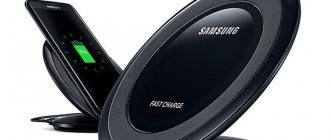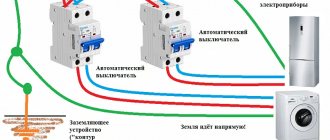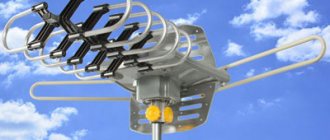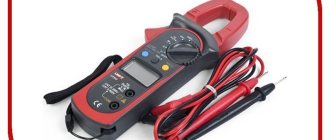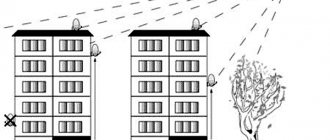Initially, when routers became popular, they had one antenna on board. Do you remember the retractable antenna on the first cell phones? No? And they were! Now you won’t surprise anyone with two or more antennas on a router. In principle, it may not be visible at all. It can be hidden, like on modern smartphones. In this article we will look at why some routers have so many antennas.
Why are antennas needed?
It is clear that any modem is a transceiver device. Initially, we connected to the Internet using cable. And at that time these devices were good. Now an antenna has appeared in the Router ↔ Computer chain. What type it is, hidden or open, doesn’t matter. The main thing is that without it it is impossible to transmit radio waves over distances.
Currently, all devices are equipped with an antenna:
- smartphones;
- Wi-Fi adapters;
- Wi-Fi routers.
Moreover, they may not be visually visible. And we are interested in the location of all antennas of the router.
There used to be phones with antennas sticking out. Now such models are no longer produced. The antenna itself remains, but it is not visible visually. Now they are inside the device.
This phenomenon fully applies to routers. If you have such a device in front of you, but the antenna is not visible, then remember, it is definitely present there. There are no routers, especially those with Wi-Fi functionality, without an antenna. Moreover, there may be several of them:
- one;
- pair;
- three;
- four or more.
As a rule, they are now external. This does not make the signal stronger. It's just that the antenna gain is higher. And the power directly depends on the transmitting device inside the router. This ensures the stability of the radio signal and increases the range. Now we have figured out that the main thing in a transmitting device is the gain. It is due to this that the Wi-Fi coverage area is expanded.
Now, let's move on to the question of why a router needs a lot of antennas.
Operating principle
The router has a very simple operating principle. A router is a device responsible for distributing the Internet to one or more devices using a network cable or Wi-Fi network.
It can also connect devices on an internal network to each other, allowing data to be shared internally, even without a public internet connection.
This happens because a router assigns an IP address to every computer or mobile phone connected to the network, and it is through them that you can access other devices and exchange files with them - that's what the router does.
How it works and its actual purpose
A router is a device that allows you to connect one computer network to another.
It provides routing of packets between two networks, that is, it determines the route along which information should go in one direction or another.
When a user accesses a URL, the web client (browser) contacts the domain name server, which specifies the IP address of the desired device. The workstation sends a request to the nearest router, that is, the default gateway of the network on which it is located.
Router in access point mode
Thus, this router will determine the next computer to which the data will be sent, in order to select the best possible path for transmitting information.
To achieve this, the device is marked with routing tables, which are actual maps of routes that can be followed to reach a destination address. There are many protocols dedicated to this task.
By figuring out how a Wi-Fi router works, you can better understand how it differs from other devices.
How many antennas are needed?
Old systems were equipped with one antenna, and, at that time, this was enough for slow Internet speeds of one or two megabits per second.
But as time passed, the speeds increased. Old network equipment simply did not meet the new requirements.
For fast Internet, Wi-Fi must be much faster. To improve performance, it was decided to add a second antenna, because one could not cope with the reception and transmission of data (SISO) at the increased speed.
Two or more
Two antennas on the router ensured simultaneous operation of both reception and transmission using MIMO technology. Accordingly, the speeds also increased - up to 144 Mbit/s.
It must be said that modern smartphone models also have two antennas.
Let's add one more
If a 3x3 MIMO or 2x3 MIMO configuration is used for data transmission, then a third antenna may be needed, which also works for reception/transmission. This supports wireless networks at 216 Mbps. If the router can work using the TurboQAM or NitroQAM protocol, then the speed can increase significantly!
What if there are four
For an ordinary apartment with an Ethernet connection via twisted pair, there is no point in additional “antennae”. Theoretically, the speed can be 100 Mbps, but in reality it is lower.
And if you use a simple telephone line using the xDSL protocol, then the real speed is generally 20–30 Mbit/s. In this case, the optimal device would be a router with either two antennas or a built-in one.
It’s another matter if the Internet is distributed via fiber optic networks. They can provide speeds of 1 Gbps and higher. Here's an opportunity:
- live broadcasts of streaming video;
- chatting in Internet;
- Online Games;
- quality TV;
- telephone.
In this case, the use of routers with four “whiskers” will be justified. Especially if there are several Internet users in the house, and everyone has different preferences.
Operating modes and connectivity options
The Wi-Fi signal travels through the router in radio bands, which act as invisible highways. Each lane is an independent path, storing data along separate traces to prevent congestion.
Because some devices require more bandwidth than others, a router's efficiency depends on the number of bands it operates on: single-band, dual-band, or tri-band.
A tri-band backbone (or tri-band router in this case) consists of one 2.4 GHz channel and two 5 GHz channels to serve more users simultaneously. This is a big benefit for families with eight or more devices that have high bandwidth.
How Wi-Fi is used also determines which router best suits your needs.
For example, a tri-band router is a great option if the user regularly streams movies or TV series on multiple TVs, there is an avid gamer in the family, or you need to work from home and have a dedicated band for home office traffic.
On the other hand, if you use the Internet very formally, primarily for sending email or checking social networks, a dual-band router will be more than enough.
Antennas are very important
We position the router correctly
It may seem strange, but there are some users who consider it a worthy place to place something that is not conspicuous or has an outlet nearby. They don't think about how the router is positioned and how this will affect signal reception/transmission. If the device is installed by a specialist, then he already knows in advance how to properly place and install the equipment.
So where should the router's antennas be located and how should it stand? Obviously, the best position is in the center of the room.
This is partly true. If the apartment is one-room. What if there are two or three rooms?
If there is a dividing wall, then the place for the router is in the largest room on the wall that separates two adjacent rooms. But there are limitations. Household devices such as a refrigerator, microwave oven, stabilizers and other electrical appliances will interfere with the propagation of the radio signal. Therefore, it is better to stay away from all such devices.
It would also be a good idea to take into account where the Internet client is located in neighboring residential premises. The most advantageous installation point is at an equidistant distance from all network consumers. This is the best place to place your device.
Router antenna direction
For those who have a router with an internal antenna, this section is not relevant. But if there are two or more “antennae” on the router, then the question of how to correctly position the antennas of the Wi-Fi router will be very acute.
It is possible to adjust the distribution to the parameters of the apartment. But it is necessary to take into account such a parameter as the gain. The greater its value, the more the radius of wave propagation expands.
Now the most important thing is how the radio wave propagates. If this coefficient approaches unity, then the shape of the influence zone is closer to spherical. But modern devices have a coefficient greater than 1.0. Therefore, the shape of the coverage area is disk-shaped. In other words, the signal increases at the edges of the antennas, and decreases at the top or bottom of the “disk”.
What follows from this:
- In the first case, the coverage area of the router can extend to several floors of the building.
- In the second, it is suitable for premises within a one-story house.
Now comes the fun part. Often modern models have several radio channels, for example, by the number of antennas. Therefore, if all the “antennae” are directed in different directions, then we will thereby change the reception/transmission zones along different planes. This will increase the range of the router.
It is also necessary to remember that antennas come in two types:
- Narrowly directed - the signal is collected into a beam and goes in the desired direction.
- Omnidirectional works in all directions.
A router with omnidirectional antennas, and this type is mainly used in modern devices, generally does not need to be aimed specifically somewhere.
Let's return to routers with built-in antennas. They are initially recommended to be mounted vertically on the wall. But since there may be more built-in antennas, for such models the vertical or horizontal position does not matter. Any directional transmission option will ensure stable operation of the device. You can even advise and work with different positions to see when the signal is best.
Changing settings
There is another option to improve the quality of the radio pulse - change its settings. Let's consider why to do this.
Your signal may be clogged by transmissions from your neighbors’ router behind the wall, who also distributes Wi-Fi, but to their own apartment and, worst of all, on the same frequency. As a result, you will not receive enough Internet from this.
This problem can be solved by switching to another channel. Most routers do this. They can select the least loaded channel and go to it. To do this, you need to activate the “Auto” item in the list of Wi-Fi channels. Alas, not all devices have this function.
You can try increasing the radio signal power. However, this option is limited to the range from 0 to 100%. But if your router has the ability to increase the power level above the standard values, then this can save the situation.
The increase in power violates State Radio Frequency Commission standards. No one, of course, will control you, but still, keep this in mind.
How to improve your home Wi-Fi: tips for dummies!
We remind you that attempts to repeat the actions of the author may lead to loss of warranty on the equipment and even to its failure, as well as to problems in the operation of the software and OS. The material is provided for informational purposes only. If you are going to reproduce the steps described below, we strongly advise you to carefully read the article to the end at least once. The editors of 3DNews do not bear any responsibility for any possible consequences.
In general, there are countless materials with tips on setting up Wi-Fi on the Internet, but not all of them are equally useful. Strictly speaking, there is simply no universal advice on this topic: everyone has different models of routers and client devices, different operating conditions, and so on. But everyone has the same problems: low connection speed, disconnections, high delays. However, we have tried to collect the most relevant tips for solving them, focusing on simplicity. There are no puzzling technical things here, and the terms are very, very minimal. This is a deliberate simplification.
Please note that we are considering the most typical situation in an ordinary city apartment with one router. However, for a private one-story house the principles are the same, but for two or more floors there are already nuances. Options with signal repeaters, additional access points and other tricks like PLC are not considered. The material is structured according to the following principle: at the very beginning there is a list of key points, and then more detailed explanations for each of them. Each section is independent of the other, that is, you can follow the recommendations not in the order given in the article. Go!
Correct placement of the router
The router should be placed so that:
- If possible, it was equidistant from client devices and was not located near a window;
- between the router and clients there were as few barriers as possible made of materials that greatly affected the signal;
- there were no sources of electromagnetic radiation or powerful electrical appliances nearby - especially microwaves, baby monitors, radio tubes and their bases;
- at least at the level of a regular work/desk or higher, but not on the floor;
- the antennas or housing were positioned as indicated in the instructions (for external antennas, a vertical position is normal);
- it was freely ventilated and cooled;
- The devices most critical to network quality could be connected via cable rather than via Wi-Fi.
Before you delve into the settings or engage in other shamanism, you should try the easiest way to improve the performance of your home Wi-Fi - correctly placing the router. Often, users are not interested in this issue, and the provider’s installers are not eager to do additional work, so the router is placed where it is closest and easiest to install an external cable. As a rule, this is an entrance hall or a room closer to the shield on the site, which is not always optimal. In general, it is difficult to give any universal advice for everyone, so it is better to experiment with the placement of the device. If it is possible to connect devices sensitive to network access via wire, then it is best to do just that. Wi-Fi is good, but copper is better!
The best option in theory is to place the router in the center of the apartment, at least somewhere at table level or higher. The thing is that antennas in home routers are almost always omnidirectional. To put it in a very simplified way, in the top view you can imagine that the signal from the router diverges in concentric circles, gradually weakening. So if you place it, for example, in the corner of a rectangular apartment, then three quarters of the coverage will be outside it. It is clear that it is unlikely to be possible to place the device in the center - it is necessary to somehow supply the provider’s cable and power. But on the floor plan you can at least roughly estimate where it can be placed so that the coverage is maximum. And at the same time, assess where the greatest concentration of clients will be or where the Wi-Fi devices that are most sensitive to the quality will be located - so you should install the router closer to them.
In this case, several more factors must be taken into account. A wireless signal propagates well in open space, but in real life there are always some obstacles between its source and consumers that affect it to one degree or another - absorb or reflect. These are walls, doors, interior items, household appliances and so on. Objects with a high metal content have the greatest impact on the signal: doors or beams, reinforced concrete walls and ceilings, glass with metallization and mirrors, housings of large household appliances such as a stove or refrigerator, some ceramic coatings and products. A smaller, but still very noticeable effect is exerted by large volumes of water (a large aquarium, for example), brick and stone (usually as part of walls), some finishing materials and insulation. Well, objects made of plastic, wood, ordinary glass, drywall, and fabric have the weakest effect.
Now the Wi-Fi standard can operate in two radio bands: 2.4 and 5 GHz. Moreover, the 5 GHz signal fades faster than the 2.4 GHz signal. The peculiarity of both ranges is that they were not originally intended exclusively for Wi-Fi. On the contrary, these frequencies do not require licensing and separate registration of devices, subject to certain rules, primarily regarding the emitted power. In fact, in the same 2.4 GHz region, many signal sources coexist, which in this case are interference. These include various radio-controlled devices (from cars to drones), baby monitors, wireless music systems, cordless phones (not DECT), keyboards/mice and other manipulators with their own adapters. In general, all sorts of proprietary and not very proprietary communication systems, as well as Bluetooth devices, although specifically for BT they came up with mechanisms for coexistence with Wi-Fi.
But this is actually not all. Do you know what the scariest beast is for Wi-Fi? An ordinary microwave! It also operates in the 2.4 GHz band, and no protection can protect against the leakage of powerful radiation, which at best simply reduces the speed and stability of data transmission over Wi-Fi, and at worst completely extinguishes the network. In next place in terms of harmfulness are the same radiotelephones and baby monitors, which even in standby mode seriously emit noise. And we are not considering severe cases when all sorts of wireless systems naturally eat up the frequencies of several Wi-Fi channels at once, although they do not comply with the standard. In general, almost any electrical equipment in one way or another generates electromagnetic noise, which does not necessarily affect Wi-Fi directly, but is quite capable of affecting other components of the router. And it’s better to keep the router away from it - at least a couple of meters. There is, however, another source of interference directly inside modern routers - USB 3.0 ports! But we learned to deal with them a long time ago: they are isolated from the radio part, and in the settings you can always enable USB 2.0 mode. Also, a good USB 3.0 cable with normal shielding usually helps with problems with them.
And of course, your Wi-Fi can be interfered with... that's right, someone else's Wi-Fi! All modern routers are required to regularly scan the radio air in order to work better. We’ll talk about channel settings a little later, but for now it’s enough to know the fact that your router is constantly “listening” to what’s happening around it. The above example with placing the device in a corner is bad not only because you yourself lose coverage, but also because in this way the router begins to better “hear” the neighbor’s Wi-Fi, which, most likely, has such a strong influence on your client devices does not provide. For the same reason, you should not place the router near the window or on the windowsill, since it will probably immediately “find out” about a bunch of neighboring networks, which certainly do not “finish off” the interior of the apartment. Residents of a number of cities can separately “thank” one large ISP, which - well, not itself, but dishonest subcontractors, strictly speaking - during a global network update, even supplied grandmothers with routers with Wi-Fi turned on, which they have not needed for a hundred years.
So, it is advisable to place the router taking into account the above factors. That is, place it so that there are fewer obstacles between it and the clients, and the obstacles themselves affect the signal as little as possible. Well, so that there are no sources of interference nearby. In addition, it is worth paying attention to the orientation of the device and antennas - the user manual usually shows a typical arrangement. As a rule, the same external antennas should be extended vertically. Finally, another important point - routers tend to heat up during operation, so they should not be placed near heating or other heated appliances. It is imperative to ensure proper ventilation of the device. No, you don’t need to install a separate fan for it, but there should always be air flow: the cases are made with holes for a reason.
Software and firmware update
To update the firmware and driver for all devices:
- use built-in OS mechanisms;
- go to the manufacturer’s website, find and then install the latest versions of the software.
Let's move on from general tips on router placement to more practical ones. And the first one will be the most obvious, but for some reason it is regularly forgotten: update the software on all devices! Seriously, decent manufacturers update drivers and firmware for a reason. This phenomenon cannot be called widespread, but still, developers really, if not radically improve the operation of devices, then at least make adjustments. For example, they update parameters to comply with the rules of individual countries and regions, which tend to change regularly. And in general, it has been said many times that any complex modern device is largely software, and not hardware at all.
Smartphones, tablets and other mobile devices usually have built-in firmware update systems. As a last resort, they are also posted on official websites - along with fairly detailed instructions that must be strictly followed. The same applies to the routers themselves - for them, the most important thing is to have the latest software. macOS users don't have much to worry about, as all the latest drivers for native adapters come with updates to the OS itself. And even Apple has finally overcome the old problem with Wi-Fi. Linux users have no idea why they are reading this material. There are several options for Windows. If it is a laptop or branded PC, then it makes sense to go to the manufacturer’s website and look for the latest drivers in the downloads or support section.
If there is nothing like this on the website or it is a self-assembly, then you will have to tinker a little, finding out which Wi-Fi adapter is installed in the system. In Windows 7, to do this you will have to go to the section “Control Panel\Network and Internet\Network and Sharing Center\Change adapter settings”. In Windows 10, the path is the same, only in the Start menu you first need to find the so-called classic Control Panel (you can just start typing this name directly into the menu). The section that opens will show all network adapters. We need an active wireless adapter whose icon is not gray and without a cross in the corner if you are already connected to your home Wi-Fi. When you double-click on the adapter icon, a window with its status will open, where you need to click on the “Properties” button. The full name of the adapter will be indicated at the top.
Then there are also two ways. Or try to find the latest drivers - they are usually provided in the form of a ready-made installer - on the adapter manufacturer's website, but, generally speaking, they are not always there. If they are not there, then it is better not to go to any unofficial sites, but to use the driver update built into Windows. In the same window, just click on the “Configure…” button right under the name of the adapter and in the new window go to the “Driver” tab, where, in turn, click the “Update...” button. And there it is already clear that you need to select automatic search. If you are afraid that something will go wrong, then before performing all operations in the OS, you can make a restore point according to the instructions for Windows 7 or. If all this does not improve the situation with your home wireless network, then there is nothing to do - you will have to turn to the settings of the router itself.
Selecting and changing the Wi- Fi
To select the appropriate Wi-Fi settings you will need:
- use a Wi-Fi broadcast analyzer and select the channel that is farthest from neighboring ones;
- remember that for 2.4 GHz there are only three non-overlapping channels for the standard channel width and only two for the extended one;
- know that for 5 GHz, most likely, only channels 36 to 48 are suitable;
- test the Band steering function, if available, and disable it if necessary.
It was already noted above that the router always scans the state of the air around it. Why is he doing this? We'll have to delve a little deeper into the theory. Previously, again, it was noted that there are dedicated radio frequency ranges. For better use, they are divided into separate pieces called channels. Depending on the region and country, the rules for their use may change, so it is important that the region in the settings of both the router and other devices is the same. Sometimes this is determined by indirect signs such as keyboard layouts, interface language, time zone, parameters of neighboring Wi-Fi networks, and so on. There are 13 such channels in the 2.4 GHz range, but the operation of Wi-Fi on any of them affects neighboring channels too. In fact, channels with a step of five between each other do not intersect or interfere with each other: 1, 6 and 11. Worse, but also quite acceptable, is the following distribution: 1/4/7/11 or 1/5/9/13. If we are talking about more modern standards with double the channel width (40 MHz instead of 20 MHz), then there is no room left at all: for example, only the 3rd and 11th channels will work without intersections.
What does all this mean in practice? But here’s the thing: only modern routers have relatively recently introduced the function of dynamically selecting a Wi-Fi channel depending on what other wireless networks are nearby and what channels they occupy. The idea is to choose a channel for your Wi-Fi that is furthest away from those around you. If your router has such a function, then it’s definitely worth enabling it. Somewhere you can even choose an interval; often changing the channel once a day is enough. And if there is no such function, then you will have to select the channel manually. There are many utilities for this. Windows users can use inSSIDer Lite, Acrylic Wi-Fi Home, LizardSystems Wi-Fi Scanner. For Mac OS X there is WiFi Explorer Lite, AirRadar. For Android there are good free analyzers Wifi Analyzer and WiFiAnalyzer (open-source). But for iOS, Apple once banned such utilities, so there are no direct analogues, but if you find something worthy, share it in the comments.
The interface of all such utilities is approximately the same. You can view a list of your neighbors' Wi-Fi channels and see their signal strength on a graph, as well as how many channels overlap nearby wireless networks. The signal level is indicated in negative numbers - the closer this number is to zero, the stronger the signal. For regular 20 MHz channels, it simply shows its number, but for 40 MHz channels, it actually shows the numbers of the two 20 MHz channels that are in use. At the same time, such utilities show which neighboring networks operate on the same channel as yours, and which channels overlap - both of which can interfere with Wi-Fi. What to do with all this information? It's simple: in the settings of your router you need to set a channel that is farthest from neighboring networks, both in number and signal strength.
In the 5 GHz range, the principles are the same, only there are more channels available, and they themselves are wider (80 MHz or 80+80/160 MHz). All of them are divided into two large blocks: from 36th to 64th and from 100th to 165th channels. Formally, all of them are allowed in the Russian Federation, but in fact, even devices that know how to work with the second block of channels may not see them. Yes, yes, this is one of the main reasons why you should update your software. The upper block is usually cleaner than the lower one, that is, there is less neighbor Wi-Fi, but you will have to check each client individually to see if he can connect to his home Wi-Fi. In addition, there is one more nuance regarding regulations regarding power and protection against interference for various third-party equipment. Without going into details, all channels above 48 may work worse than others.
In modern dual-band routers, a function called Band steering, Dual-band Wi-Fi, Smart Connect, or something like that is becoming increasingly common. Its essence is that the router automatically “pushes” clients into the range that it considers most preferable at the moment. Typically, a prerequisite for this technology to work is the same Wi-Fi network name for both bands, so you can disable it simply by renaming the network of one of the bands. There is no single standard for this technology, and it works very differently. The best option, perhaps, should be considered a preferred connection to a 5 GHz network. Well, if this technology doesn’t bring anything good to your home Wi-Fi, then you can turn it off.
Additional settings
What else can you do:
- abandon older devices that only support Wi-Fi 802.11b or 802.11g;
- select the correct Wi-Fi operating mode, that is, 802.11n or 802.11g/n for 2.4 GHz and 802.11n or 802.11n/ac for 5 GHz;
- leave auto-selection of channel width, that is, 20/40 MHz for 2.4 GHz and 20/40/80 or 20/40/80/160 MHz for 5 GHz;
- try disabling non-standard additional Wi-Fi acceleration technologies;
- try to slightly reduce the power of the Wi-Fi radio module;
- on mobile devices, disable access to the 3G/4G network when within Wi-Fi coverage;
- Check the power saving modes of devices and adapters.
There are now two modern Wi-Fi standards: 802.11n (2.4 GHz and 5 GHz) and 802.11ac (5 GHz). However, users may also have older devices that support, for example, only 802.11g, or even the ancient 802.11b or even 802.11a standard by modern standards. The latter, however, are now very difficult to find, but if you suddenly happen to have them, then it is best to completely abandon them (and if the router only supports 802.11b/g, then you should definitely throw it away), since they can significantly slow down Wi-Fi operation. Why? Because the router always tries to organize communication by providing the most common capabilities for all clients, which may make old devices comfortable, but not so much for new ones. If there are 802.11g devices and you can also refuse them, then it is better to do so. Some router models have special settings that, in theory, allow old devices to connect without interfering with new ones, but they do not always work correctly. The type of standard supported can be found in the description of the device or its wireless adapter.
So, for the 2.4 GHz band, the most preferred operating mode is 802.11n (only), followed by 802.11g/n. For 5 GHz there is only one optimal option: 802.11n/ac. The situation with channel width is this: according to the rules, the router must understand and accept all devices that comply with the standard. So in the settings you should select the option 20/40 MHz (for 2.4 GHz) and 20/40/80 or 20/40/80/160 MHz (for 5 GHz). Some routers allow you to force the maximum possible channel width. Yes, this sometimes helps to squeeze out all the juice from a wireless connection, but not always and not for all devices. Moreover, if only stability is important, then it makes sense, on the contrary, to reduce the channel width. Similar settings can be checked on the adapter side by following the same steps as in the section about updating drivers, but selecting the “Advanced” tab at the end. However, in these settings there is usually such a scattering of parameter names that it is better to change any of them very carefully, and if you are not sure, then do not touch them at all.
Routers have a number of additional functions that are also worth paying attention to. Various “accelerators” can cause a lot of headaches, since they are almost always technologies that go beyond the standard. For older devices there are XPress or TxBurst functions, while new ones have TurboQAM/256-QAM or NitroQAM/1024-QAM. Beamforming technology, typically available in explicit (newer devices) or implicit (older devices) formats, like all of the above, can improve the experience for some clients but harm others. You don’t have to think too much about MU-MIMO for now; this technology is still not widely available on clients. However, you can and should experiment with these settings, turning them on/off and observing the behavior of client devices. It’s definitely worth leaving the WMM option enabled, but with different classification systems (QoS) and restrictions (shaping), you’ll also have to check different scenarios or disable it completely.
There is one more - absolutely counterintuitive - setting regarding the power of the radio transmitter. Typically, you can either specify the power in milliwatts, or select/specify the power level as a percentage of the maximum. So, maximum power is not always good! Without going into details, let's say that a decrease, on the contrary, can significantly improve the quality of communication. To begin with, you can try to lose 15-25 percent and see what happens. It’s exactly the same story with external antennas that have a higher gain (which is not always true) and other Wi-Fi “improvements” like homemade or purchased reflectors - they can cause harm. If you have good relations with your neighbors, then you can set up non-overlapping channels for them in the same way, reduce the power and place the router correctly - you will help both others and yourself.
Finally, for smartphones, tablets and other mobile devices there are a couple more very simple steps. Firstly, when you get into a Wi-Fi zone, you should turn off mobile Internet access on them, as well as options like Wi-Fi Assist in iOS. Secondly, it makes sense to check the power saving settings everywhere, both for the OS as a whole and for the wireless adapters themselves. Both can affect the consistency of your home Wi-Fi connection.
Conclusion
Finally, one more simple but important piece of advice: if you are not confident in your abilities, then it’s better not to take it on. And if you are afraid to forget what and where you changed, then use the backup and restore function, which is available in almost any modern router. However, not all and far from the most difficult settings for the average person are given here, and experts may not even agree with some of the advice. However, if none of the recommendations individually (or all together) helped, then either they are not applicable to your situation, or it’s really time to worry about buying a new router, or even additional access points. We hope this does not happen to you!


